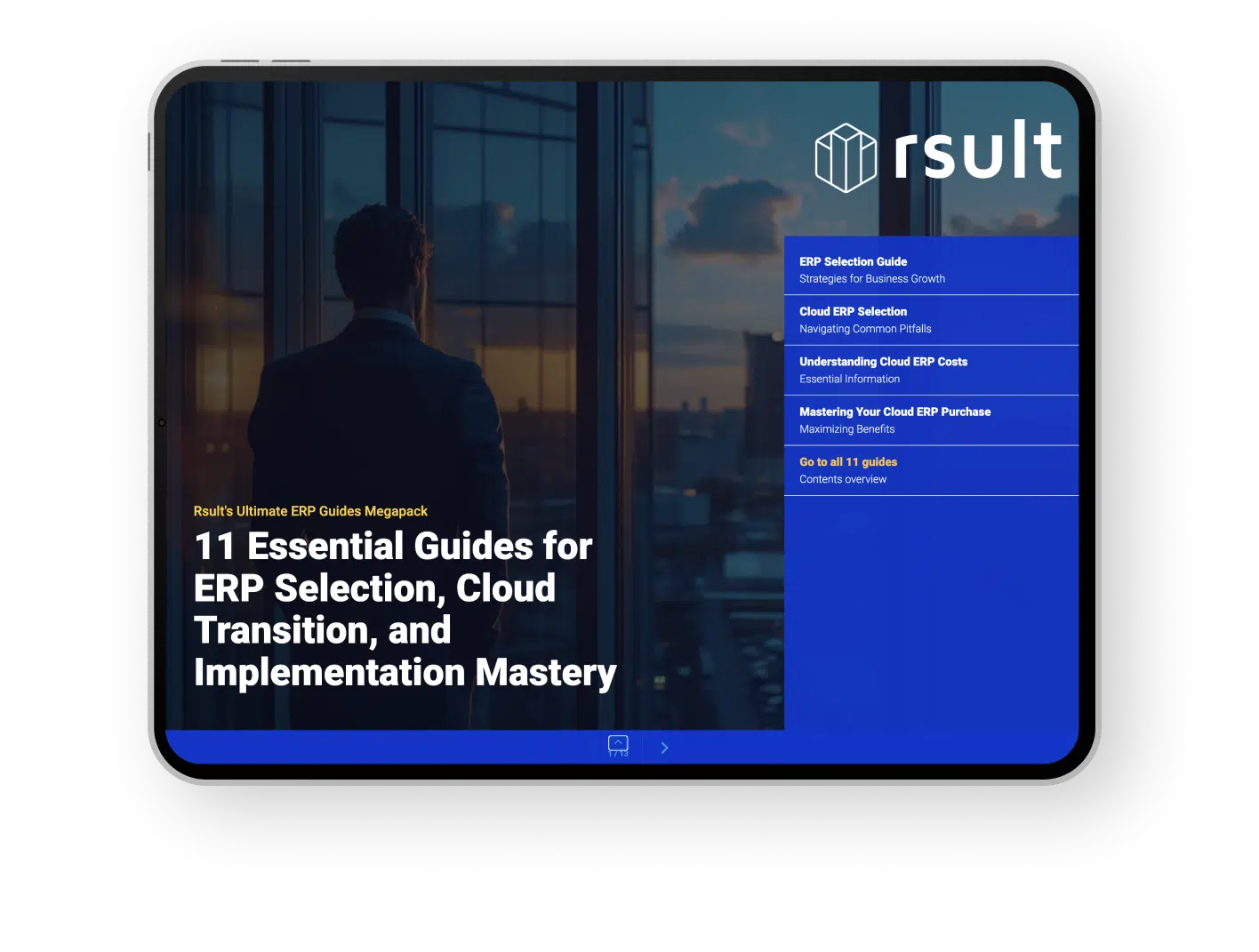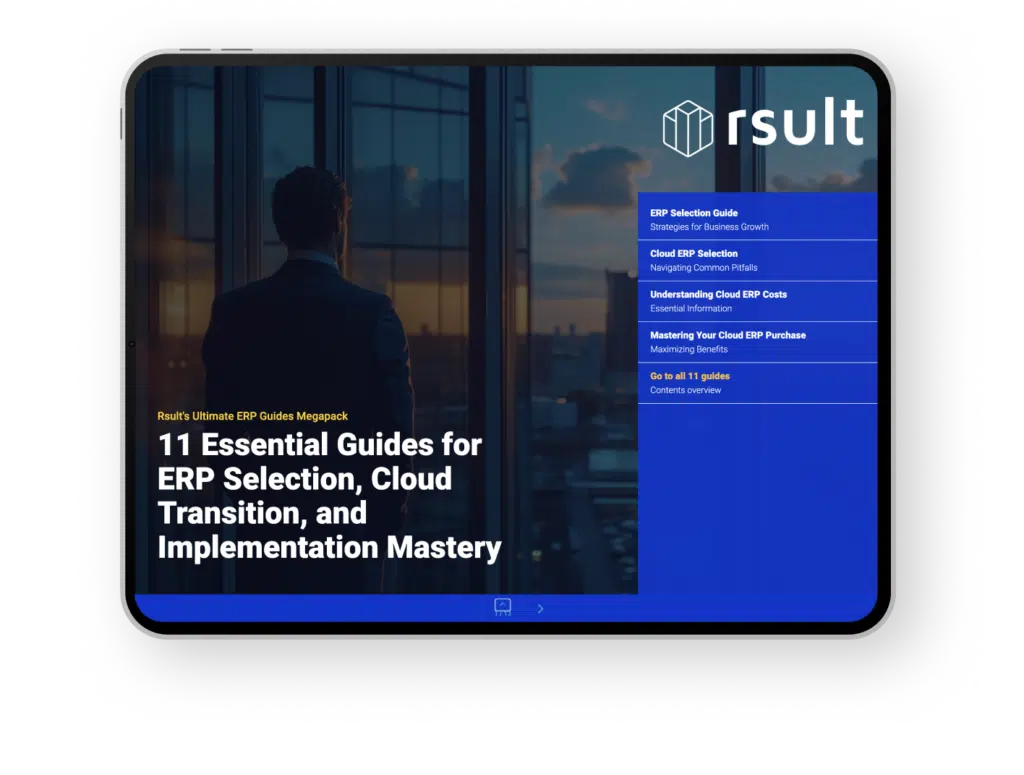Navigating the ERP implementation process can seem daunting, but with
the right strategies in place, it simplifies into a series of
manageable steps. Whether you’re a small business owner or a leader
within a large corporation, understanding ERP deployment strategies
is key to ensuring that the introduction of an integrated management
system adds value to your operations. This guide to successful ERP
implementation will walk you through the crucial tactics for a smooth
rollout, steering your project towards success without overwhelming
those involved. From garnering strong executive support to building a
cross-functional project team, the goal is to thoroughly equip you
with the know-how to enhance your business through ERP implementation.
Key Takeaways
- Understanding the various stages of an effective ERP implementation process.
- Identifying key ERP deployment strategies tailored to fit your business needs.
- Recognizing the importance of executive sponsorship in a successful ERP rollout.
- Emphasizing the benefits of a cross-functional project team in the ERP journey.
- Appreciating the significance of a meticulous plan for ERP integration.
- Ensuring the ERP system aligns with your business’s core operations for optimal results.
Understanding the Scope of ERP Integration in Business Processes
When companies embark on integrating an ERP (Enterprise Resource Planning) system into their operations, they unlock a myriad of benefits of ERP integration. At the heart of this endeavor is the ambition to bring together disparate business functions like finance, operations, and human resources into a singular, interconnected system. The primary driver for this unification is the enhancement of operational efficiency and the delivery of actionable, real-time data to decision-makers.
To truly comprehend the magnitude of benefits received from a well-executed ERP integration, it’s vital to recognize the multiphase journey this encompasses. This journey spans across meticulous ERP system configuration, encompassing analysis, design, implementation, testing, deployment, and consecutive maintenance phases. The cumulative effect of these phases can streamline business processes, uplift productivity, promote cost savings, and bolster data accuracy across the organizational spectrum.
Understanding the scope of ERP system configuration goes beyond a technical setup; it’s about identifying areas in your business where processes might be inefficient or fragmented and determining how the ERP system can mend these gaps. By doing so, businesses are not only preparing themselves for a transformational change in their business process management but also setting the stage for a paradigm shift towards holistic and integrated business operations.
- Streamlined Operations: Unification of business processes leads to much smoother workflows.
- Fiscal Prudence: Optimization of resources and reduction in redundancy naturally leads to cost savings.
- Data-driven Decisions: With integrated data insights, strategic decisions are better informed and timely.
By deeply understanding and exploiting the full benefits of ERP integration, businesses are well-equipped to optimize their operations. These efficiencies, when effectively harnessed, can position an organization strongly within its competitive landscape and pave the way for sustained, long-term success.
The Importance of a Solid ERP Implementation Plan
The success of implementing ERP systems hinges upon the creation of a meticulously detailed plan that aligns with the organizational objectives. A well-crafted strategy not only sets the stage for the project’s progression but also anticipates and mitigates potential setbacks. By establishing clear milestones and expectations, businesses can navigate the complexities involved in such transitions with confidence and clarity.
Aligning Your Plan with Business Goals
To achieve the maximum benefit from an ERP project management initiative, it’s essential to ensure that the deployment strategy is in perfect harmony with the company’s vision and long-term goals. This symbiosis optimizes operational efficiency and fosters a competitive edge in the market.
Building an Inclusive ERP Project Team
Fostering a diverse and skilled ERP project team is a cornerstone in the steps for implementing ERP. This team should reflect a cross-section of the company and include individuals who can champion the project from executive levels to end users. The collective expertise and commitment of the team serve as a catalyst for a successful implementation and sustainable change.
| ERP Project Team Role | Responsibilities | Selection Criteria |
|---|---|---|
| Executive Sponsor | Secures funding, resolves cross-departmental challenges, provides strategic oversight. | Leadership experience, influence in the organization, understanding of business vision. |
| Project Manager | Oversees project timeline, manages resources, communicates with stakeholders. | Project management skills, ERP implementation experience, exceptional communication abilities. |
| IT Specialist | Ensures technical feasibility, manages system integration, supports data migration. | Technical expertise in ERP systems, problem-solving skills, knowledge of company IT infrastructure. |
| Business Analyst | Aligns ERP features with business processes, analyzes data flow, recommends improvements. | Understanding of business operations, analytical mindset, experience in process optimization. |
| Change Manager | Facilitates user adoption, plans training programs, monitors change impact. | Adept at change management strategies, skilled in communication, training experience. |
| End User Representatives | Provide feedback, assist with user acceptance testing, serve as departmental advocates. | Operational expertise, collaborative outlook, willingness to embrace new technology. |
The road map for a smooth ERP deployment is one that prioritizes the company’s needs, lays out clear steps for implementing ERP, and builds a team well-versed in the nuances of implementing ERP systems. With this strategic approach, organizations can anticipate a transformation that yields lasting efficiency and success.
Implementing ERP System: The Design Phase Essentials
Embarking on the design phase of an ERP software setup demands attention to detail and a deep understanding of the company’s current workflow. It is here that an organization paves the way for a successful ERP implementation by critically assessing and re-designing business processes to align with the capabilities of the new system. Key considerations during the design phase include identifying the necessary features that an ERP system must possess to meet the unique needs of the business, understanding the extent of software customization, and planning meticulously for data migration.
A fundamental aspect of ERP software setup is the match it needs to achieve with the company’s operational DNA. Flexibility is essential because what works in theory may require adjustments in practice once the system is deployed. Often, the necessity to tweak processes emerges as teams get hands-on with the new system’s functionalities. Moreover, data, the cornerstone of all ERP solutions, needs careful analysis to ensure integrity post-migration.
Core Elements to Consider During the ERP Design Phase:
- Thorough analysis of present workflows to map out transitions
- Identification of key ERP functionalities to support business objectives
- Determining customization needs to enhance software efficiency
- Developing a strategic blueprint for data migration and integrity
Success in the design phase encompasses both planning and visionary thinking, requiring the team to foresee how the system will operate in various scenarios. Below is a comprehensive breakdown of design considerations that are crucial for a streamlined ERP software setup.
| Design Consideration | Objective | Impact on ERP Setup |
|---|---|---|
| Workflow Analysis | To identify and enhance existing processes for ERP compatibility | Ensures the ERP solution complements business operations seamlessly |
| ERP Feature Selection | To prioritize the features that directly support critical business tasks | Optimizes system performance and user experience |
| Customization Requirements | To tailor the ERP system to meet unique business demands | Minimizes the need for extensive training and reduces resistance to change |
| Data Migration Strategy | To ensure data is transferred accurately and efficiently | Preserves data integrity and minimizes system downtime |
By meticulously evaluating these factors, organizations can expect a seamless transition during ERP software setup. Businesses must be agile, yet deliberate during the design phase, as it sets the stage for a future-proof ERP system tailored to evolve with the enterprise. The goal is clear: to create a resilient foundation that will power the business through its next chapter of efficiency and growth.
Testing and Development: Ensuring Seamless ERP Software Setup
The pathway towards a seamless ERP software setup advances into a crucial phase where strategic testing and development occur. The ERP implementation process dictates thorough scrutiny of the system’s performance against the specific needs of a business before it steps into the live environment.
Configuring the ERP to Match Business Requirements
Configuring the ERP system is a meticulous process that involves tailoring the software’s features and functions to seamlessly integrate with the business’s current operations. This stage is fundamental for the ERP software setup, ensuring that the software not only fulfills the company’s needs but also adds value by enhancing efficiency and productivity.
- Analysis of current business processes against ERP capabilities
- Customization of modules to fit operational workflows
- Setting up user roles and permissions for data security
- Development of user-friendly dashboards and reporting tools
Data importation and the creation of training materials are also essential during this phase, requiring a cooperative effort from both the IT department and end-users to ensure data integrity and usability.
Comprehensive Testing Strategies Before Deployment
Prior to deployment, a rigorous testing strategy is deployed to iron out any wrinkles in the ERP software setup. This process includes a series of planned tests, each designed to verify that every component of the ERP system is operating correctly and is ready to handle real-world business scenarios.
| Test Type | Description | Objective |
|---|---|---|
| Unit Testing | Individual module testing for specific functions | Ensure each module performs as designed |
| System Testing | Assessment of the complete ERP system’s functionality | Validate the fully integrated system before going live |
| Stress Testing | Evaluates performance under high stress/loads | Determine how the ERP handles heavy data and user load |
| User Acceptance Testing (UAT) | Testing by actual software users in real scenarios | Confirm the ERP meets business needs and user requirements |
Adopting a holistic approach to the ERP implementation process not only paves the way for a robust ERP software setup but also sets the stage for a smooth transition and optimal user adoption post-deployment.
ERP Deployment Strategies: Big Bang vs Phased Rollout
When it comes to rolling out a new Enterprise Resource Planning (ERP) system, the choice of ERP deployment strategies can make all the difference. The primary approaches are the ‘big bang’ strategy, which entails a full switch over to the new system at one go, and the phased rollout, where the ERP is introduced in stages. This decision is influenced by many factors, from the size and culture of the organization to how quickly they anticipate a return on investment.
With the ‘big bang’ approach, the switch is instantaneous. All users move to the new ERP system simultaneously, a transition that offers a quick pathway to realizing the benefits of the new system but also poses significant risk if something goes awry. On the other hand, the phased rollout method reduces risk by implementing the ERP solution in manageable portions, allowing adjustments to be made step by step.
Pros and Cons of Each Strategy:
- Big Bang: Cost-effective in the short term, reduces complexity by avoiding parallel systems, but higher risk and requires extensive training and support.
- Phased Rollout: Lower immediate risk, allows for gradual adaptation to the new system, but potentially more costly and extended over a longer period.
Choosing the right ERP deployment strategy is pivotal, as it sets the stage for how well the organization will adapt to the new system. The tables below offer a comparative look at these two popular ERP deployment strategies:
| Criteria | Big Bang Approach | Phased Rollout |
|---|---|---|
| Timeframe | Immediate | Gradual, over weeks/months/years |
| Risk | High | Lowered per phase |
| Cost | Potentially lower upfront | Higher due to prolonged process |
| Change Management | Intensive | More manageable |
| User Training | Required for all at once | Staggered; can evolve |
| Deployment Complexity | Very high | Depends on phase |
| Organization Impact | Potential for significant disruption | Minimized disruptions |
| ROI Realization | Quicker possible returns | ROI realized incrementally |
When planning your ERP deployment strategies, it’s critical to weigh these factors against your company’s specific goals, resources, and capabilities. Whether you opt for the immediacy and overarching transformation of the big bang approach or the cautious, step-by-step precision of the phased rollout, preparation and alignment with your organization’s needs are the keys to a successful ERP deployment.
Maximizing Benefits of ERP Integration
Across industries, harnessing the benefits of ERP integration is pivotal to shaping a more efficient, insight-driven business model. When ERP system configuration is approached strategically, companies can unleash powerful improvements in operations and management. From streamlining processes to fostering data-driven decision-making, effective ERP solutions are an investment in your company’s future.
Strategies for Immediate and Long-Term Business Improvements
Immediate and substantial improvements are often the primary pursuit upon implementing a new Enterprise Resource Planning (ERP) system. One strategy is to prioritize areas that directly impact revenue or customer service, as enhancements in these zones can lead to rapid returns. Simplifying and automating financial reporting, for instance, provides quick gains by reducing manual labor and errors. To sustain these improvements over the long term, it’s essential to plan for continued evolution and scalability of your ERP system, thus safeguarding your technological investment.
Extracting the Full Potential of ERP Features
To fully realize the benefits of ERP integration, a deep dive into the ERP system’s multifaceted features is crucial. This involves a commitment to thorough ERP system configuration, ensuring that each component is tailored to your unique business needs. From advanced analytics to mobile accessibility, each function presents an opportunity to elevate productivity and streamline workflows. Below is a breakdown of targeted ways to extract the full potential of your ERP system:
- Optimizing inventory management to reduce holding costs and improve order fulfillment.
- Enhancing customer relationship management to provide personalized services and improve retention.
- Automating routine tasks to allow staff to focus on strategic initiatives.
- Implementing robust analytics for improved forecasting and resource management.
Central to these steps for implementing ERP is a continuous improvement mindset, where feedback loops and data analytics guide ongoing refinements. In doing so, not only can your business operations become more effective, but they also become poised for agile adaptation in a dynamic market environment.
| ERP Feature | Immediate Benefits | Long-Term Advantages |
|---|---|---|
| Financial Management | Reduced processing time for transactions | Strategic financial planning based on trend analysis |
| Supply Chain Operations | Streamlined procurement process | End-to-end visibility and optimization of the supply chain |
| Human Resources | Automated payroll and attendance systems | Enhanced talent management and workforce analytics |
| Customer Relationships | Faster response rates to customer inquiries | Improved customer data insights for up/cross-selling opportunities |
Project Management Best Practices in ERP Implementation
Embarking on the journey of an ERP implementation necessitates a well-oiled project management machinery to steer the venture towards its desired outcome. The linchpin of effective ERP project management lies in the meticulous alignment with an organization’s business objectives. It’s imperative to sustain the impetus of the project and manage an array of stakeholder inputs with diligence.
Avoiding the trap of scope creep is indispensable within ERP project management and fostering the discretion to recognize essential enhancements as opposed to merely desirable ones becomes a critical skill. Moreover, the multifaceted nature of ERP project management extends to orchestrate system configuration, the adaptation of business processes, and the secure management of data privacy and security protocols.
- Strengthen ERP project management with strategic alignment to business objectives
- Preserve project momentum and manage stakeholder engagement effectively
- Identify and mitigate scope creep to stay on track
- Recognize critical system enhancements to drive project value
- Configurate ERP systems suiting dynamic business process requirements
- Uphold rigorous data security and privacy standards
- Execute comprehensive training for end-user adoption and proficiency
Aside from these strategical points, comprehensive and structured training takes center stage to fortify the successful adoption and proficient usage of the ERP system. Training goes beyond mere knowledge sharing; it involves equipping the workforce with the right toolset to work in tandem with the newly implemented system features effectively.
These practices coalesce to frame a robust backbone for an ERP implementation that not only transitions smoothly but also adds enduring value to the organization. Centralizing project management efforts around these core tenets ensures a productive, secure, and well-adopted ERP system that aligns seamlessly with an organization’s ongoing and evolving needs.
The Core Role of Data in ERP System Configuration
Data is the linchpin of any ERP system configuration, underpinning the entire ERP implementation process. Ensuring data accuracy and integrity is not just a supplementary part of the ERP system configuration; it’s integral to the operation and success of the entire ERP architecture. Through a diligently executed data migration plan, businesses safeguard the foundation upon which all ERP functionalities are built.
Auditing and Cleansing Data for Successful Migration
Before data can be effectively utilized in a new ERP system, it must undergo a rigorous audit. This means meticulously reviewing the existing data for accuracy, completeness, and redundancy. Data cleansing is a key step that often uncovers critical issues before they can disrupt the ERP implementation process. Ensuring the data is ‘clean’ before migration not only enhances performance but also streamlines the adoption of the new system across all departments.
Validation and Governance in Data Management
Robust data validation processes and governance are paramount within the ERP system configuration. A scheme must be in place to continuously monitor and maintain data quality throughout the ERP system’s lifecycle. This extends beyond initial implementation, involving ongoing checks to verify that data remains accurate and consistent, thereby fortifying the system against future errors and inefficiencies.
| Data Quality Dimension | Description | Impact on ERP Implementation |
|---|---|---|
| Accuracy | Ensuring data precisely reflects real-world attributes values. | Prevents incorrect business decisions based on faulty data. |
| Completeness | All necessary data is present and no critical elements are missing. | Enables comprehensive analysis and utilization within the ERP system. |
| Consistency | Data is the same across all databases and systems. | Facilitates reliable data integration and reporting. |
| Integrity | Data is secure, with enforced relationships and free from corruption. | Protects the operational stability of the ERP implementation. |
Guide to Successful ERP Implementation: Training for Impact
One of the essential steps for implementing ERP is equipping your workforce with the necessary training to effectively utilize the new system. Comprehensive training is vital to ensure that your staff has a deep understanding of the ERP software, enabling them to perform daily transactions with confidence and resolve any potential issues swiftly.
When considering the steps for implementing ERP, a variety of instructional methods can be employed, such as:
- Interactive online courses for convenience and self-paced learning
- In-person classroom sessions for collaborative learning environments
- One-on-one mentoring to address specific queries and enhance user understanding
- Blended learning approaches that combine digital and face-to-face instructional techniques
It is pivotal to craft a tailored training program that encompasses the following:
| Training Focus Area | Description | Expected Outcome |
|---|---|---|
| System Knowledge | An in-depth overview of the ERP software’s features and functionalities. | Employees understand the capabilities and the interface of the ERP system. |
| Transactional Procedures | Step-by-step instructions on how to execute common tasks within the ERP system. | Staff becomes proficient at processing daily transactions accurately and efficiently. |
| Troubleshooting Methods | Guidance on identifying and resolving system-related issues. | Users are able to address minor system issues independently, reducing downtime. |
Fostering a culture of continuous learning and improvement through training is as essential as the technical steps for implementing ERP. It maximizes user engagement and ensures that your team is capable of leveraging all the functionalities that ERP software has to offer. With well-trained employees, your organization will be better placed to realize the full benefits of ERP integration.
ERP System Utilization and Post-implementation Support
After the initial launch of an ERP system, the emphasis swiftly shifts to effective utilization and support to solidify the benefits of your investment. Aiding users in navigating the new system with robust post-ERP implementation support is crucial for minimizing downtime and maximizing productivity. Setting up a reliable support framework ensures that any issues users encounter can be swiftly resolved, making the transition as smooth as possible for every department within the organization.
Establishing Effective User Support Systems
Creating an environment wherein users feel supported involves establishing a support infrastructure that can respond rapidly to their needs. This includes help desks manned by knowledgeable staff, easily accessible online resources, and proactive monitoring systems that flag and address common challenges. Such ERP system utilization efforts are geared toward providing users with the tools and assistance they need to overcome the learning curve and making the system work effectively for their specific job functions.
Leveraging Feedback for Continuous Improvement
To further enhance the ERP experience, it’s vital to engage users in a dialogue through which they can share feedback about the system. This active engagement is a treasure trove for insights on how to refine the system and improve its functionality. By listening to those who work with the ERP system daily, organizations can continue to evolve their processes, addressing post-implementation challenges and optimizing system use for long-term success and satisfaction.






